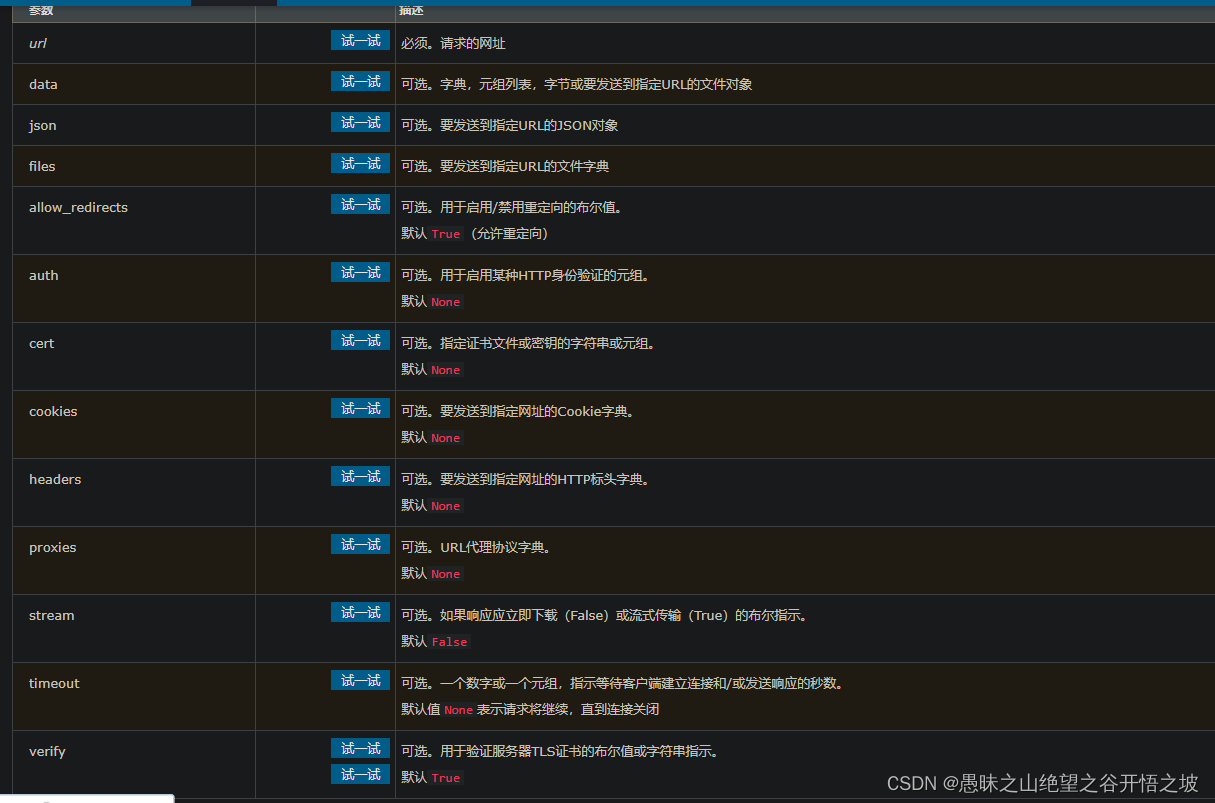python基于request库,调用聊天机器人接口,request的几种方式汇总
参考网站案例:
https://www.begtut.com/python/ref-requests-post.html
https://blog.csdn.net/junli_chen/article/details/53670887
参考官方:https://requests.readthedocs.io/en/latest/api/?highlight=post#requests.post

1、post请求方式
一个http请求包括三个部分,为别为请求行,请求报头,消息主体,类似以下这样:
请求行
请求报头
消息主体
HTTP协议规定post提交的数据必须放在消息主体中,但是协议并没有规定必须使用什么编码方式。服务端通过是根据请求头中的Content-Type字段来获知请求中的消息主体是用何种方式进行编码,再对消息主体进行解析。具体的编码方式包括:
application/x-www-form-urlencoded
最常见post提交数据的方式,以form表单形式提交数据。
application/json
以json串提交数据。
multipart/form-data
一般使用来上传文件。
1.1 以form形式发送post请求
Reqeusts支持以form表单形式发送post请求,只需要将请求的参数构造成一个字典,然后传给requests.post()的data参数即可。
url = 'http://httpbin.org/post'
d = {'key1': 'value1', 'key2': 'value2'}
r = requests.post(url, data=d)
print r.text
输出:
{
“args”: {},
“data”: “”,
“files”: {},
“form”: {
“key1”: “value1”,
“key2”: “value2”
},
“headers”: {
……
“Content-Type”: “application/x-www-form-urlencoded”,
……
},
“json”: null,
……
}
可以看到,请求头中的Content-Type字段已设置为application/x-www-form-urlencoded,且d = {‘key1’: ‘value1’, ‘key2’: ‘value2’}以form表单的形式提交到服务端,服务端返回的form字段即是提交的数据。
1.2 以json形式发送post请求
可以将一json串传给requests.post()的data参数,
url = 'http://httpbin.org/post'
s = json.dumps({'key1': 'value1', 'key2': 'value2'})
r = requests.post(url, data=s)
print r.text
输出:
{
“args”: {},
“data”: “{\”key2\”: \”value2\”, \”key1\”: \”value1\”}”,
“files”: {},
“form”: {},
“headers”: {
……
“Content-Type”: “application/json”,
……
},
“json”: {
“key1”: “value1”,
“key2”: “value2”
},
……
}
可以看到,请求头的Content-Type设置为application/json,并将s这个json串提交到服务端中。
1.3 以multipart形式发送post请求
Requests也支持以multipart形式发送post请求,只需将一文件传给requests.post()的files参数即可。
url = 'http://httpbin.org/post'
files = {'file': open('report.txt', 'rb')}
r = requests.post(url, files=files)
print r.text
输出:
{
“args”: {},
“data”: “”,
“files”: {
“file”: “Hello world!”
},
“form”: {},
“headers”: {……
“Content-Type”: “multipart/form-data; boundary=467e443f4c3d403c8559e2ebd009bf4a”,
……
},
“json”: null,
……
}
2、案例
def request_post(data):
r = requests.post("xx", data=data)
print(r.text)
print(type(r.text))
print(eval(r.text))
print(type(eval(r.text)))
return eval(r.text)
调用
data_ = {'description': '防疫政策', 'id': '3'}
request_post(data_)
返回,默认返回的字符串类型,eval后变成字典类型
<class 'str'>
{'current_id': '3', 'similar_id_list': [{'166': 0.9442330598831177}, {'901': 0.9388024806976318}, {'140': 0.9371911287307739}]}
<class 'dict'>
subscriptable,可下标的
3、聊天机器人案例
import os
import pandas as pd
import requests
from database.connect_database_mysql import ConnectDatabaseMysql
from config_env.config_envi import common, select_env
connect_database = ConnectDatabaseMysql(select_env)
def request_post(data):
r = requests.post("xx", data=data)
result = eval(r.text)
print(result)
id_list = [key for res in result['similar_id_list'] for key in res.keys()]
sql_read_field = 'id,question,answer'
sql = "select %s from %s where id in (%s, %s, %s, %s, %s)" % (sql_read_field, common['mysql_table'],
id_list[0], id_list[1], id_list[2],
id_list[3], id_list[4])
result_pd = pd.read_sql_query(sql, connect_database.con_target)
index2ans = dict(zip(result_pd['id'], zip(result_pd['question'], result_pd['answer'])))
answer_list = [index2ans[int(id_)] for id_ in id_list]
return answer_list
if __name__ == '__main__':
while True:
human_utterance = input("Please enter your question:").strip()
data_ = {'description': human_utterance, 'id': '3', 'top_k': '5'}
robot_utterance = request_post(data_)
print("[Bot answer]: %s" % robot_utterance)
相关文章
- Python中Selenium模块的使用
- 【Python】ValueError: unsupported pickle protocol: 5解决方案/同一个项目 python环境尽量保持一致
- python是否存在某个字符串 效率最高_Python中判断子串存在的性能比较及分析总结...
- Python 卸载python
- 掌握Python语言能做什么?python对小白友好吗?
- 零基础自学Python需要多长时间从入门到精通?学python能兼职挣钱吗?怎么挣钱?
- Python分享:python爬虫可以用来做什么?
- 手把手|用Python端对端数据分析识别机器人“僵尸粉”
- 机器人系统设计与制作:Python语言实现1.4 如何制作机器人
- 《python 与数据挖掘 》一 第2章 Python基础入门
- python实现快速排序算法
- 《Python密码学编程》——1.6 如何使用加密轮盘解密
- 《像计算机科学家一样思考Python》——3.3 数学函数
- Python 教程之如何使用 matplotlib 在 python 中绘制数学函数
- Python代码大全之sqlite通过参数update数据
- 【历史上的今天】12 月 23 日:Python 起源;TCP/IP 协议发明者出生;设计第一台 PC 的人诞生
- PySpider python 爬虫
- Python当中的array数组对象
- 2.1 The Python Interpreter(python解释器)
- Python操作Windows

